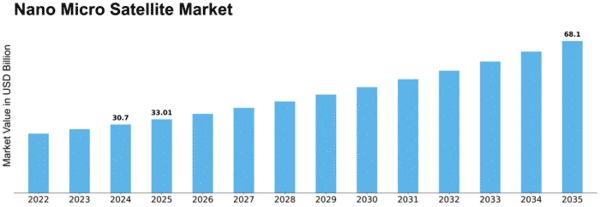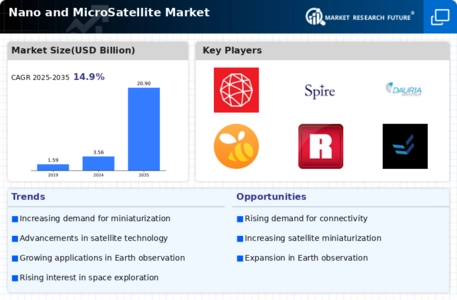-
Executive Summary
-
Market Attractiveness Analysis
- Global Nano And Micro Satellite Market, By Component
- Global Nano And Micro Satellite Market, By Mass
- Global Nano And Micro Satellite Market, By End User
- Global Nano And Micro Satellite Market, By Application
- Global Nano And Micro Satellite Market, By Region
-
Market Introduction
-
Market Definition
-
Scope Of The Study
-
Market Structure
-
Key Buying Criteria
-
Market Factor Indicator Analysis
-
Research Methodology
-
Research Process
-
Primary Research
-
Secondary Research
-
Market Size Estimation
-
Forecast Model
-
List Of Assumptions
-
Market Insights
-
Market Dynamics
-
Introduction
-
Drivers
-
Restraints
-
Opportunities
-
Challenges
-
Market/Technological Trends
-
Patent Trends
-
Regulatory Landscape/Standards
-
Market Factor Analysis
-
Value Chain/Supply Chain Analysis
- R&D
- Manufacturing
- Distribution & Sales
- Post-Sales Monitoring
-
Porter’s Five Forces Analysis
- Threat Of New Entrants
- Bargaining Power Of Buyers
- Threat Of Substitutes
- Rivalry
- Bargaining Power Of Supplies
-
Global Nano And Micro Satellite Market, By Component
-
Introduction
-
Hardware
- Market Estimates & Forecast, 2020-2030
- Market Estimates & Forecast, By Region, 2020-2030
-
Software & Data Processing
- Market Estimates & Forecast, 2020-2030
- Market Estimates & Forecast, By Region, 2020-2030
-
Service
- Market Estimates & Forecast, 2020-2030
- Market Estimates & Forecast, By Region, 2020-2030
-
Launch Service
- Market Estimates & Forecast, 2020-2030
- Market Estimates & Forecast, By Region, 2020-2030
-
Global Nano And Micro Satellite Market, By Mass
-
Introduction
-
1 Kg-10 Kg
- Market Estimates & Forecast, 2020-2030
- Market Estimates & Forecast, By Region, 2020-2030
-
11 Kg-100 Kg
- Market Estimates & Forecast, 2020-2030
- Market Estimates & Forecast, By Region, 2020-2030
-
Global Nano And Micro Satellite Market, By End User
-
Introduction
-
Commercial
- Market Estimates & Forecast, 2020-2030
- Market Estimates & Forecast, By Region, 2020-2030
-
Defense
- Market Estimates & Forecast, 2020-2030
- Market Estimates & Forecast, By Region, 2020-2030
-
Civil
- Market Estimates & Forecast, 2020-2030
- Market Estimates & Forecast, By Region, 2020-2030
-
Government
- Market Estimates & Forecast, 2020-2030
- Market Estimates & Forecast, By Region, 2020-2030
-
Maritime & Transportation
- Market Estimates & Forecast, 2020-2030
- Market Estimates & Forecast, By Region, 2020-2030
-
Energy & Infrastructure
- Market Estimates & Forecast, 2020-2030
- Market Estimates & Forecast, By Region, 2020-2030
-
Global Nano And Micro Satellite Market, By Application
-
Introduction
-
Earth Observation And Remote Sensing
- Market Estimates & Forecast, 2020-2030
- Market Estimates & Forecast, By Region, 2020-2030
-
Scientific Research
- Market Estimates & Forecast, 2020-2030
- Market Estimates & Forecast, By Region, 2020-2030
-
Communication
- Market Estimates & Forecast, 2020-2030
- Market Estimates & Forecast, By Region, 2020-2030
-
Academic Training
- Market Estimates & Forecast, 2020-2030
- Market Estimates & Forecast, By Region, 2020-2030
-
Mapping And Navigation
- Market Estimates & Forecast, 2020-2030
- Market Estimates & Forecast, By Region, 2020-2030
-
Biological Experiment
- Market Estimates & Forecast, 2020-2030
- Market Estimates & Forecast, By Region, 2020-2030
-
Technology Demonstration And Verification
- Market Estimates & Forecast, 2020-2030
- Market Estimates & Forecast, By Region, 2020-2030
-
Reconnaissance
- Market Estimates & Forecast, 2020-2030
- Market Estimates & Forecast, By Region, 2020-2030
-
Global Nano And Micro Satellite Market, By Region
-
Introduction
-
North America
- Market Estimates & Forecast, By Country, 2020-2030
- Market Estimates & Forecast, By Component, 2020-2030
- Market Estimates & Forecast, By Mass, 2020-2030
- Market Estimates & Forecast, By Application, 2020-2030
- Market Estimates & Forecast, By End User, 2020-2030
- US
- Canada
-
Europe
- Market Estimates & Forecast, By Country, 2020-2030
- Market Estimates & Forecast, By Component, 2020-2030
- Market Estimates & Forecast, By Mass, 2020-2030
- Market Estimates & Forecast, By Application, 2020-2030
- Market Estimates & Forecast, By End User, 2020-2030
- UK
- Germany
- France
- Italy
- Rest Of Europe
-
Asia-Pacific
- Market Estimates & Forecast, By Country, 2020-2030
- Market Estimates & Forecast, By Component, 2020-2030
- Market Estimates & Forecast, By Mass, 2020-2030
- Market Estimates & Forecast, By Application, 2020-2030
- Market Estimates & Forecast, By End User, 2020-2030
- China
- Japan
- India
- Rest Of Asia-Pacific
-
Middle East & Africa
- Market Estimates & Forecast, By Country, 2020-2030
- Market Estimates & Forecast, By Component, 2020-2030
- Market Estimates & Forecast, By Mass, 2020-2030
- Market Estimates & Forecast, By Application, 2020-2030
- Market Estimates & Forecast, By End User, 2020-2030
- UAE
- Saudi Arabia
- Rest Of The Middle East & Africa
-
Latin America
- Market Estimates & Forecast, By Country, 2020-2030
- Market Estimates & Forecast, By Component, 2020-2030
- Market Estimates & Forecast, By Mass, 2020-2030
- Market Estimates & Forecast, By Application, 2020-2030
- Market Estimates & Forecast, By End User, 2020-2030
- Brazil
- Rest Of Latin America
-
Competitive Landscape
-
Competitive Overview
-
Competitor Dashboard
-
Major Growth Strategies In The Global Nano And Micro Satellite Market
-
Competitive Benchmarking
-
Market Share Analysis
-
Airbus SAS.: The Leading Player In Terms Of Number Of Developments In The Global Nano And Micro Satellite Market
-
Key Developments & Growth Strategies
- Product Launches/Service Deployments
- Mergers & Acquisitions
- Joint Ventures
-
Company Profiles
-
Airbus SAS
- Company Overview
- Products/Services Offered
- Financial Overview
- Key Developments
- SWOT Analysis
- Key Strategies
-
Boeing
- Company Overview
- Products/Services Offered
- Financial Overview
- Key Developments
- SWOT Analysis
- Key Strategies
-
Clyde Space Ltd
- Company Overview
- Products/Services Offered
- Financial Overview
- Key Developments
- SWOT Analysis
- Key Strategies
-
GeoOptics
- Company Overview
- Products/Services Offered
- Financial Overview
- Key Developments
- SWOT Analysis
- Key Strategies
-
GomSpace
- Company Overview
- Products/Services Offered
- Financial Overview
- Key Developments
- SWOT Analysis
- Key Strategies
-
Innovative Solutions In Space BV
- Company Overview
- Products/Services Offered
- Financial Overview
- Key Developments
- SWOT Analysis
- Key Strategies
-
Lockheed Martin Corporation
- Company Overview
- Products/Services Offered
- Financial Overview
- Key Developments
- SWOT Analysis
- Key Strategies
-
Planet Labs, Inc.
- Company Overview
- Products/Services Offered
- Financial Overview
- Key Developments
- SWOT Analysis
- Key Strategies
-
Raytheon Company
- Company Overview
- Products/Services Offered
- Financial Overview
- Key Developments
- SWOT Analysis
- Key Strategies
-
RUAG Group
- Company Overview
- Products/Services Offered
- Financial Overview
- Key Developments
- SWOT Analysis
- Key Strategies
-
Sierra Nevada Corporation
- Company Overview
- Products/Services Offered
- Financial Overview
- Key Developments
- SWOT Analysis
- Key Strategies
-
SpaceQuest Ltd
- Company Overview
- Products/Services Offered
- Financial Overview
- Key Developments
- SWOT Analysis
- Key Strategies
-
The Aerospace Corporation
- Company Overview
- Products/Services Offered
- Financial Overview
- Key Developments
- SWOT Analysis
- Key Strategies
-
Tyvak Nano-Satellite Systems, Inc.
- Company Overview
- Products/Services Offered
- Financial Overview
- Key Developments
- SWOT Analysis
- Key Strategies
-
Vector Launch, Inc.
- Company Overview
- Products/Services Offered
- Financial Overview
- Key Developments
- SWOT Analysis
- Key Strategies
-
Appendix
-
References
-
Related Reports
-
List Of Abbreviations
-
Industry Insights
-
List Of Tables:
-
Global Nano And Micro Satellite Market, By Region, 2020-2030
-
North America: Nano And Micro Satellite Market, By Country, 2020-2030
-
Europe: Nano And Micro Satellite Market, By Country, 2020-2030
-
Asia-Pacific: Nano And Micro Satellite Market, By Country, 2020-2030
-
Middle East & Africa: Nano And Micro Satellite Market, By Country, 2020-2030
-
Latin America: Nano And Micro Satellite Market, By Country, 2020-2030
-
Global Nano And Micro Satellite Market Size, By Region, 2020-2030
-
North America: Nano And Micro Satellite Market Size, By Country, 2020-2030
-
Europe: Nano And Micro Satellite Market Size, By Country, 2020-2030
-
Asia-Pacific: Nano And Micro Satellite Market Size, By Country, 2020-2030
-
Middle East & Africa: Nano And Micro Satellite Market Size, By Country, 2020-2030
-
Latin America: Nano And Micro Satellite Market Size, By Country, 2020-2030
-
Global Nano And Micro Satellite Component Market, By Region, 2020-2030
-
North America: Nano And Micro Satellite Component Market, By Country, 2020-2030
-
Europe: Nano And Micro Satellite Component Market, By Country, 2020-2030
-
Asia-Pacific: Nano And Micro Satellite Component Market, By Country, 2020-2030
-
Middle East & Africa: Nano And Micro Satellite Component Market, By Country, 2020-2030
-
Latin America: Nano And Micro Satellite Component Market, By Country, 2020-2030
-
Global Nano And Micro Satellite Mass Market, By Region, 2020-2030
-
North America: Nano And Micro Satellite Mass Market, By Country, 2020-2030
-
Europe: Nano And Micro Satellite Mass Market, By Country, 2020-2030
-
Asia-Pacific: Nano And Micro Satellite Mass Market, By Country, 2020-2030
-
Middle East & Africa: Nano And Micro Satellite Mass Market, By Country, 2020-2030
-
Latin America: Nano And Micro Satellite Mass Market, By Country, 2020-2030
-
Global Nano And Micro Satellite Application Market, By Region, 2020-2030
-
North America: Nano And Micro Satellite Application Market, By Country, 2020-2030
-
Europe: Nano And Micro Satellite Application Market, By Country, 2020-2030
-
Asia-Pacific: Nano And Micro Satellite Application Market, By Country, 2020-2030
-
Middle East & Africa: Nano And Micro Satellite Application Market, By Country, 2020-2030
-
Latin America: Nano And Micro Satellite Application Market, By Country, 2020-2030
-
Global Nano And Micro Satellite End User Market, By Region, 2020-2030
-
North America: Nano And Micro Satellite End User Market, By Country, 2020-2030
-
Europe: Nano And Micro Satellite End User Market, By Country, 2020-2030
-
Asia-Pacific: Nano And Micro Satellite End User Market, By Country, 2020-2030
-
Middle East & Africa: Nano And Micro Satellite End User Market, By Country, 2020-2030
-
Latin America: Nano And Micro Satellite End User Market, By Country, 2020-2030
-
Global Nano And Micro Satellite Market, By Region, 2020-2030
-
Global Nano And Micro Satellite Market, By Component, 2020-2030
-
Global Nano And Micro Satellite Market, By Mass, 2020-2030
-
Global Nano And Micro Satellite Market, By Application, 2020-2030
-
Global Nano And Micro Satellite Market, By End User, 2020-2030
-
North America: Nano And Micro Satellite Market, By Country, 2020-2030
-
North America: Nano And Micro Satellite Market, By Component, 2020-2030
-
North America: Nano And Micro Satellite Market, By Mass, 2020-2030
-
North America: Nano And Micro Satellite Market, By Application, 2020-2030
-
North America: Nano And Micro Satellite Market, By End User, 2020-2030
-
Europe: Nano And Micro Satellite Market, By Country, 2020-2030
-
Europe: Nano And Micro Satellite Market, By Component, 2020-2030
-
Europe: Nano And Micro Satellite Market, By Mass, 2020-2030
-
Europe: Nano And Micro Satellite Market, By Application, 2020-2030
-
Europe: Nano And Micro Satellite Market, By End User, 2020-2030
-
Asia-Pacific: Nano And Micro Satellite Market, By Country, 2020-2030
-
Asia-Pacific: Nano And Micro Satellite Market, By Component, 2020-2030
-
Asia-Pacific: Nano And Micro Satellite Market, By Mass, 2020-2030
-
Asia-Pacific: Nano And Micro Satellite Market, By Application, 2020-2030
-
Asia-Pacific: Nano And Micro Satellite Market, By End User, 2020-2030
-
Middle East & Africa: Nano And Micro Satellite Market, By Country, 2020-2030
-
Middle East & Africa: Nano And Micro Satellite Market, By Component, 2020-2030
-
Middle East & Africa: Nano And Micro Satellite Market, By Mass, 2020-2030
-
Middle East & Africa: Nano And Micro Satellite Market, By Application, 2020-2030
-
Middle East & Africa: Nano And Micro Satellite Market, By End User, 2020-2030
-
Latin America: Nano And Micro Satellite Market, By Country, 2020-2030
-
Latin America: Nano And Micro Satellite Market, By Component, 2020-2030
-
Latin America: Nano And Micro Satellite Market, By Mass, 2020-2030
-
Latin America: Nano And Micro Satellite Market, By Application, 2020-2030
-
Latin America: Nano And Micro Satellite Market, By End User, 2020-2030
-
List Of Figures:
-
Research Process Of MRFR
-
Top-Down & Bottom-Up Approaches
-
Market Dynamics
-
Impact Analysis: Market Drivers
-
Impact Analysis: Market Restraints
-
Porter's Five Forces Analysis
-
Value Chain Analysis
-
Global Nano And Micro Satellite Market Share, By Component, 2020 (%)
-
Global Nano And Micro Satellite Market, By Component, 2020-2030 (USD Million)
-
Global Nano And Micro Satellite Market Share, By Mass, 2020 (%)
-
Global Nano And Micro Satellite Market, By Mass, 2020-2030 (USD Million)
-
Global Nano And Micro Satellite Market Share, By Application, 2020 (%)
-
Global Nano And Micro Satellite Market, By Application, 2020-2030 (USD Million)
-
Global Nano And Micro Satellite Market Share, By End User, 2020 (%)
-
Global Nano And Micro Satellite Market, By End User, 2020-2030 (USD Million)
-
Global Nano And Micro Satellite Market Share (%), By Region, 2020
-
Global Nano And Micro Satellite Market, By Region, 2020-2030 (USD Million)
-
North America: Nano And Micro Satellite Market Share (%), 2020
-
North America: Nano And Micro Satellite Market, By Country, 2020-2030 (USD Million)
-
Europe: Nano And Micro Satellite Market Share (%), 2020
-
Europe: Nano And Micro Satellite Market, By Country, 2020-2030 (USD Million)
-
Asia-Pacific: Nano And Micro Satellite Market Share (%), 2020
-
Asia-Pacific: Nano And Micro Satellite Market, By Country, 2020-2030 (USD Million)
-
Middle East & Africa: Nano And Micro Satellite Market Share (%), 2020
-
Middle East & Africa: Nano And Micro Satellite Market, By Country, 2020-2030 (USD Million)
-
Latin America: Nano And Micro Satellite Market Share (%), 2020
-
Latin America: Nano And Micro Satellite Market, By Country, 2020-2030 (USD Million)


















Leave a Comment